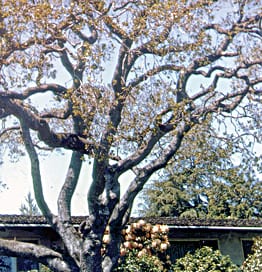OAK DECLINE COMPLEX.
Caused by one or more of the following fungi:
Botryodiplodia querci, Fusarium solani, Cephalosporium diospyri, Pestalotia macrosporum, Diplodia quercina, Phialophora sp., Dothiorella querci, Verticicladiella sp., Fusarium oxysporum, Verticillium albo-atrum
All oak species are hosts.
This complex has been reported throughout the continental United States.
Drought (soil moisture levels below 60% field capacity), with air temperatures above 60° F. Root damage from transplanting, construction, or compaction all contribute.
Symptoms vary according to host and fungus involved. Initial discoloration of leaf margins, sometimes with interveinal yellowing; later total yellowing possible, followed by stunting, slow to quick wilting, and dieback; usually evident first in upper crown. Leaves may or may not fall prematurely. As disease progresses individual branches may have thinner foliage, followed by a thinning of the entire crown. Vascular discoloration varies with organism, red-brown to black-blue, in twigs and/or root crown. Tree may die in as few as 2-3 months, or death may be gradual over 3-8 years.
Lethal infection, generally through roots from soilborne phase of fungus. Some of the fungi (Botryodiplodia, Diplodia) may become established as twig-canker inciters, at which stage decline is slow. Falling branches and twigs may introduce the fungus to the root area.


